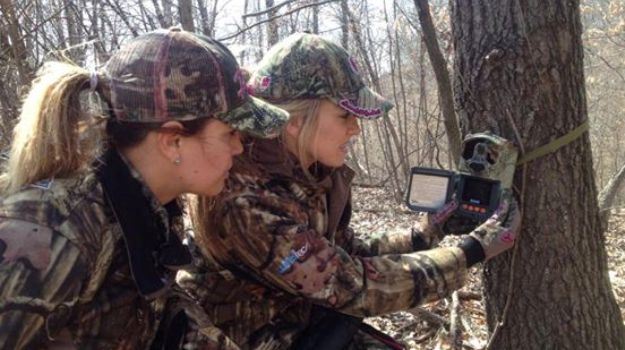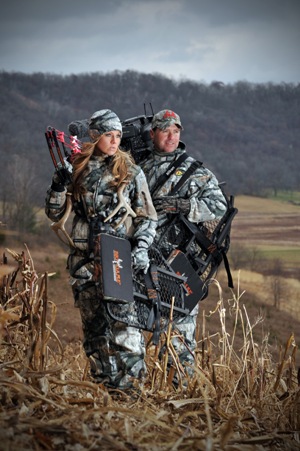
Editor’s Note: Pat Reeve lives in Plainview, Minnesota, and has been a member of the Mossy Oak Pro Staff for 9 years. He and his wife Nicole produce “Driven with Pat and Nicole” (www.drivenhunter.com) on the Outdoor Channel.
If you’ve seen the list of shows that will be on “Driven with Pat and Nicole” on the Outdoor Channel, then you’ve seen that we hunt all over the country and out of the country every year. I’m often asked, “How do you hunt a property you’ve never hunted before and take big bucks?” Many people may think 3 days is all that’s required to find and take a big buck, but that’s not true. For instance, when we go to Canada, I know that more than likely we’ll have 1 or 2 days during our hunt that we may have bad weather that’ll prevent us from hunting. So on most of our hunts, I plan to hunt at least 5 to 7 days and sometimes more.
For instance, this year we’re going to Alberta to hunt. I plan for that hunt to last at least 15 days. I’ll have to hang my own stands, do my own scouting, put-out trail cameras and try to find an older-age-class buck to hunt. Basically, we just have permission to hunt on this property. So, I’ll have to do all the leg work that an outfitter normally does. I plan to spend 6 or 7 days scouting, trying to find a buck to hunt and several places to put up tree stands and ground blinds where I think I can take a buck.
After that 5 or 6 days of scouting, I’ll leave the property and go to Saskatchewan to an area I've hunted for several years. Usually in 5 days, Nicole and I can fill our tags on that hunt. In Saskatchewan, you can use attractants and bait to cause the deer to come out to take a shot. But when we’re hunting in Alberta, Canada, we have to trust our scouting skills to find where the deer are, where they’re moving, and where’s the best place to put-up our stands. We have to find the food sources, bedding areas and travel trails the deer are using. In that kind of situation when we’re hunting new ground, we rely heavily on our Big Game Eyecon trail cameras to help locate the deer. We rely on the pictures that the camera takes when we’re not hunting on the property.
Once we finish our hunting in Saskatchewan, we’ll return to Alberta where we’ve set-up our trail cameras and tree stands. Hopefully, we’ll be able to use all the information we’ve gathered from my 5 or 6 days of scouting. Too, we’ll leave the camera out for another 5 or 6 days, and then hunt for 7 or 8 days to possibly take an older-age-class buck.
So, the best case scenario is: when I go to an new area I like to have about 5 to 6 days to scout, leave my trail cameras out for another 5 to 6 days, then come back and take the information from the trail cameras to try and identify one or two bucks that we want to take. Then I spend 7 to 8 days trying to take the bucks we've found.
 Power Scouting
Power Scouting
If I have only 7-days total to be at a hunting destination, I have to rely on what I call power scouting. Power scouting starts by talking to the landowner, the outfitter, a mail man, the farmer or any other people spending time on or around the property I'm going to hunt. I ask them where they’re seeing big deer on the property, and what the deer are currently doing. I ask where they’ve seen a big deer in the last 2 weeks. I go to Google Earth and get an aerial photo of the property. Next I try to determine where the food sources are. Next I look for funnels on the land. I wear rubber boots and scent-free clothing and go into those areas. Hopefully on a windy or a rainy day, these preparations will help disguise my sound and my scent. I go to the funnel areas and look for trails that converge into that funnel. I search for buck sign, including big tracks. I look for the direction these tracks are traveling. I search for rubs on the sides of trees that are as big as your thigh, and I look for the direction the rubs are facing, which will indicate the direction a mature buck has come from, and I look for scrapes.
I search for deer like bass fishermen look for bass at tournaments. A bass fisherman won’t spend any time in areas that aren’t holding bass. He eliminates all the places that probably won’t be holding bass. He concentrates all his fishing time in the places that bass should be, because he's gotten bites there, or it’s the time of the year for bass to show up there, or when he pre-practices, he’s found bass holding there.
When power scouting, I want to go where mature bucks have been seen, where they’ve left sign, or where they should be feeding, watering or bedding. I take all the information I can gather, including trail-camera photos, and I put together a game plan based on all my information. Then Nicole and I can put up tree stands or ground blinds and have the greatest opportunity to take a mature buck.



























